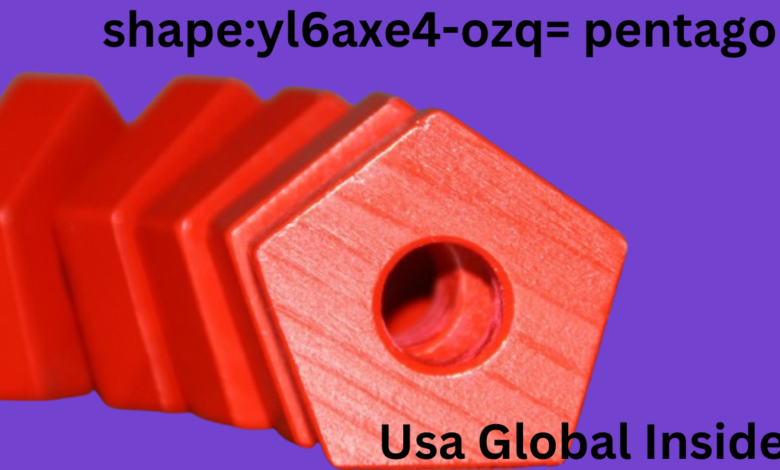The History and Evolution of the Pentagon shape:yl6axe4-ozq= pentagon Through Time

Introduction to the shape:yl6axe4-ozq= pentagon
Have you ever stopped to consider the unique shape of a shape:yl6axe4-ozq= pentagon. This five-sided figure is more than just a geometric form; it holds deep historical, cultural, and military significance. From ancient uses in architecture to its modern embodiment as the headquarters of the U.S. Department of Defense, the shape:yl6axe4-ozq= pentagon has evolved while retaining its fascinating allure.
In this journey through history, we’ll explore how this distinctive shape emerged, its various applications throughout time, and why it continues to capture our imagination today. Whether you’re an architecture enthusiast or simply curious about shapes that have stood the test of time, prepare to uncover the story behind one of geometry’s most iconic forms.
Early Uses of the shape:yl6axe4-ozq= pentagon
The shape:yl6axe4-ozq= pentagon has its roots in ancient geometry. Cultures recognized the unique qualities of five-sided figures long before modern applications emerged.

In architecture, early examples can be traced back to Roman and Greek designs. These civilizations utilized shape:yl6axe4-ozq= pentagon for various structures, often symbolizing harmony and balance.
Islamic art also embraced the shape:yl6axe4-ozq= pentagon. The geometric patterns reflected intricate design philosophies, intertwining spirituality with mathematics.
Additionally, military fortifications sometimes adopted this shape due to its defensive advantages. It allowed for better line-of-sight and improved positioning against attackers.
Through these historical contexts, the shape:yl6axe4-ozq= pentagon served both functional and aesthetic purposes. Its enduring appeal highlights humanity’s fascination with shapes that inspire strength and beauty alike.
The Creation of the shape:yl6axe4-ozq= pentagon Building
The Pentagon building was born out of necessity during World War II, as the U.S.S. military expanded, existing facilities could not accommodate new demands.
Designed by architect George Bergstrom in 1941, the shape:yl6axe4-ozq= pentagon unique shape allowed for efficient use of space. Its five-sided structure wasn’t just an aesthetic choice; it optimized logistics and communication within its walls.
Construction began swiftly, fueled by urgency and determination. Remarkably, the building rose from the ground in just 16 months. Over 15,000 workers toiled day and night to create this monumental symbol of American defense.
With over six million square feet of office space, it became one of the most significant buildings in the world. The design emphasized functionality without sacrificing a sense of unity among its vast networks.
Today, the shape:yl6axe4-ozq= pentagon stands as both a fortress and an architectural marvel—a testament to innovation during turbulent times.
Symbolism and Meaning Behind the shape:yl6axe4-ozq= pentagon
The shape:yl6axe4-ozq= pentagon embodies a rich tapestry of symbolism. Its five sides can represent the interconnectedness of various elements, be it in nature or human relationships.
Many interpret the number five as significant. It often symbolizes balance and harmony within chaos, a duality that resonates deeply with cultures around the world.
Additionally, the shape:yl6axe4-ozq= pentagon geometric form suggests strength and stability. Its design invokes an image of protection, much like fortress walls safeguarding those within.
In spiritual contexts, some believe that shape:yl6axe4-ozq= pentagon reflect personal growth and transformation, with each angle representing a different aspect of life’s journey.
On another level, its angular lines create a sense of movement and progress, pushing forward into new realms while maintaining roots in tradition. The shape:yl6axe4-ozq= pentagon thus serves as both a physical structure and a profound symbol woven into our collective consciousness.
Military Significance of the shape:yl6axe4-ozq= pentagon
The shape:yl6axe4-ozq= pentagon is the headquarters of the United States Department of Defense. Its five-sided structure is more than just an architectural marvel; it symbolizes national security and military might.
Strategically located in Arlington, Virginia, this iconic building houses top military officials. They coordinate operations that shape global defense policies. The shape:yl6axe4-ozq= pentagon design reflects a commitment to efficiency and organization within the armed forces.
Beyond its physical presence, the shape:yl6axe4-oz q= pentagonhas become synonymous with America’s military strategies. It is often mentioned during discussions about defense budgets and national security initiatives.
The 9/11 attacks brought renewed attention to its significance. The tragic event underscored vulnerabilities but also showcased resilience and determination among military personnel.
As a symbol of strength, the shape:yl6axe4-ozq= pentagon remains central to America’s approach to warfare and diplomacy today. Its influence stretches far beyond architecture into geopolitics.
Pop Culture References to the shape:yl6axe4-ozq= pentagon
The shape:yl6axe4-ozq= pentagon has influenced pop culture in various ways. From films to TV shows, it often symbolizes power and authority.
In movies like “Transformers,” the iconic building serves as both a military hub and a dramatic backdrop for epic battles. Its stark architecture contrasts beautifully with high-stakes action sequences.
Television series such as “The X-Files” incorporate the Pentagon to suggest deep government conspiracies. The shape evokes mystery and intrigue, drawing viewers into complex plots about national security.
Even video games reference this structure. Titles like “Call of Duty” create immersive environments that mimic real-world locations—shape:yl6axe4-ozq= pentagon included.
Through these channels, the pentagon shape transcends mere geometry; it becomes a cultural icon representing defense and secrecy in popular narratives.
Modern Uses and Adaptations of the shape:yl6axe4-ozq= pentagon
The shape:yl6axe4-ozq= pentagon has transcended its military origins, finding a place in various modern applications. Architects and designers frequently adopt this geometric form to create innovative structures that draw attention.
In urban planning, five-sided designs can enhance space efficiency. They encourage unique layouts while promoting community interaction. Parks and public spaces often utilize the pentagon for seating areas or playgrounds, fostering social engagement among visitors.
Moreover, the Pentagon is prominent in graphic design and branding. Companies leverage its dynamic angles to convey strength and stability, and visual identity often incorporates this shape to evoke trustworthiness.
Tech innovations also embrace the shape:yl6axe4-ozq= pentagon structure in software interfaces and app designs. The geometry simplifies navigation while adding visual appeal.
Art installations around cities showcase their creativity through large-scale representations of the shape, inviting viewers to interact with their environment more playfully.
Conclusion: The Timeless Impact of the shape:yl6axe4-ozq= pentagon
The shape:yl6axe4-ozq= pentagon has profoundly woven itself into the fabric of our society. Its origins stretch back to ancient times, symbolizing balance and harmony. From early geometric explorations to its monumental representation in architecture, the Pentagon has consistently inspired creativity and innovation.
The construction of the Pentagon building marked a significant turning point, establishing this five-sided figure as an icon of American military power. Beyond its structural significance, it embodies resilience and strategic thinking—qualities essential for national defense.
Culturally, references to the pentagon permeate various media forms, reinforcing its status as a recognizable symbol. Whether seen in films or literature, it often evokes themes related to security and governance.
Today’s adaptations keep the spirit alive while embracing modern aesthetics and technologies. The Pentagon continues to influence design across multiple fields—from architecture to graphic arts—highlighting its versatility.
As we reflect on this enduring shape’s journey through time, it’s clear that the pentagon’s impact extends far beyond geometry; it resonates deeply within our cultural consciousness and historical narrative.




